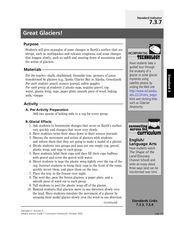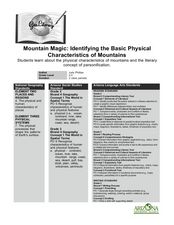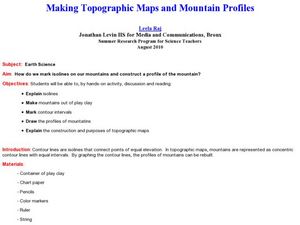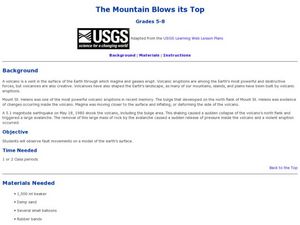Curated OER
Hungary: The Landscape
Students work in small groups to create a topographic map of Hungary. The map will include labeled line drawing of the bordering countries. Hungary should be three dimensional, made of salt and flour clay. The mountains, plains and...
Curated OER
Italy: The Landscape
Students work in small groups to create a topographic map of Italy. They must include labeled line drawings of bordering countries and bodies of water. Students use salt and flour clay to make Italy three dimensional, showing the many...
Curated OER
The Earth's BIG Features
Your students will enjoy the vivid pictures and interesting facts about world geography, in this presentation. Depicted are several major geographical features found around the world and a description of each.
Curated OER
Changing Landforms
Students investigate different types of landforms. In this landforms lesson plan, students explore landforms by participating in a WebQuest. Students research the reasons behind landforms changing and create a picture using KidPix.
Curated OER
Mountain Barriers
Students examine geographical change. In this mountain barriers instructional activity, students conduct an experiment to discover how mountains affect surrounding land. Students draw conclusions on how change in land affects plant and...
Curated OER
Landforms
In this landforms worksheet, students answer 2 questions about the major land forms and types of mountains. They match 10 landforms and types of mountains with their definitions.
Curated OER
Moon Features Activity
In this moon worksheet, students answer questions about the lunar surface and identify the features of the moon on a moon map. They include craters, bays, mountains, seas, oceans and craters.
Curated OER
Landforms
In this landform review worksheet, learners use 17 provided terms to complete a paragraph about different landforms. After filling in the blanks, they name 4 kinds of mountains and provide examples of each.
Curated OER
Lesson Plan on Volcanoes
Fourth graders are able to label a diagram of a volcano with a least 3 of the following parts: the magma chamber, vents, dome, and caldarea. They break up into groups of four and design their own volvanoes using paper and drawing...
Curated OER
Ecosystems of the World
Middle schoolers are able to list different ecosystems and describe their environment and organisms. They have an understanding about the function and balance of the ecosystems. Students are able to tell what type of ecosystem the St....
Curated OER
Earth Forces
Students use geological techniques such as plate tectonics, mountain building, earthquakes, and volcanoes, in order to explain the earth.
Curated OER
Create a Country
Students work in small groups to list features and elements found on a variety of grade- appropriate maps. They develop a class list of map features and elements to draw from as they create a map of an imaginary country.
Curated OER
Across the Landscape
Students create a unique, stunning display of the Earth's landforms. They discuss the many different types of the Earth's landforms such as deserts, mountains, oceans, plateaus, coastlines, and marshlands. Students discuss what...
Curated OER
Mountains of the World Quiz 2
In this geography skills instructional activity, students respond to 10 short answer questions featuring famous mountain ranges of the world.
Curated OER
Mountains
Explore the mountain habitat with this collection of slides. The climate is described, along with the associated plant and animal life. Some of the pictures are attractive, but some leave much to be desired. There is a generous amount of...
Curated OER
The Gifts of the Nile
Get your class thinking about the geography that shaped the Egyptian landscape and culture. They compare ancient climate zones and geogrpahical fetures, locate evidence of plate tectonics, take and quiz, and write a short essay. The...
Curated OER
Can You Name the Region?
While just a picture of the Rocky Mountains, this presentation could be used as an introductory activity to a geography lesson. The series of slides begins with a piece of a complete picture which is revealed little by little, until the...
Curated OER
Great Glaciers!
Seventh graders study the earths surface and how changes happen to it. In this glacier lesson students complete a lab activity to see how glaciers form.
Curated OER
Carving Mountains
Students explore geography by participating in an illustration activity. In this land-form lesson, students define vocabulary terms associated with glaciers and forests. Students utilize pens, cardboard and pottery clay to draw and...
Curated OER
Leapin' Landmarks: Locating 10 Man-made Landmarks Around the World
Third graders label continents, oceans, and major mountain ranges on maps and use the maps to write an informational report about landmarks. For this landmarks lesson plan, 3rd graders write about 1 major landmark.
Curated OER
Mountain Magic: Identifying the Basic Physical Characteristics of Mountains
Students read about and identify on maps the physical characteristics of mountains. In this mountains lesson plan, students also write about the characteristics using personification.
Curated OER
Making Topographic Maps and Mountain Profiles
Students study how to mark inclines and construct a mountain profile. In this topographic map lesson plan students mark contour intervals and draw mountain profiles.
Curated OER
The Mountain Blows its Top
Learners replicate a volcanic eruption. In this volcanoes lesson plan, students follow the provided procedures to show and describe how the inflation of a bulge led to the eruption of Mount St. Helens.
Curated OER
Crater Lakes and the Volcanoes of the Cascade Mountains
Students study volcanoes. In this Earth science lesson plan, students read, discuss and take notes on the volcanoes of the Cascade Mountains. This lesson plan also includes an art project.

























